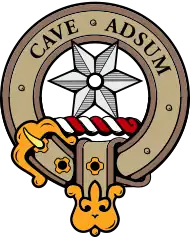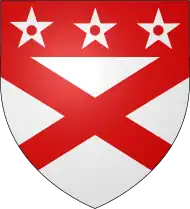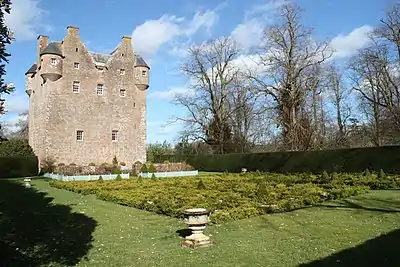Clan Jardine
Clan Jardine is a Scottish clan of the Scottish Lowlands.[2]
| Clan Jardine | |||
|---|---|---|---|
 Crest: A spur rowel of six points Proper | |||
| Motto | Cave Adsum (Beware, I am coming!) | ||
| Profile | |||
| Region | Lowlands | ||
| District | Dumfriesshire | ||
| Plant badge | Apple Blossom | ||
| Chief | |||
 | |||
| Sir William Murray Jardine of Applegirth | |||
| The 13th Baronet of Applegarth | |||
| Seat | Ash House[1] | ||
| Historic seat | Spedlings Tower[2] Jardine Hall[2] | ||
| |||
| |||
History
Origins of the clan
The surname Jardine is derived from jardin which is French for garden or orchard.[2] However the genealogist, Black, has suggested that this does not mean that they were gardeners, but that they resided near to a garden.[2]
The du Jardon family came over to England in 1066 with William the Conqueror.[2] The name is first found in Scotland in charters to Kelso Abbey and Arbroath Abbey prior to 1153, when Wmfredus de Jardin appears as a witness.[2] In about 1178 Humphrey de Jardin witnessed a charter by Robert Bruce to Arbroath Abbey.[2]
The name Jardine is also found in the form of de Gardinus and Patrick de Gardinus was chaplain to the Bishop of Glasgow during the early thirteenth century.[2] Sir Humphrey de Gardino witnessed a registration of the lands of Annandale in 1245.[2]
Another variant of the name is found in the Ragman Rolls of 1296 where Jorden del Orchard appears rendering homage for his lands in Linlithgow to Edward I of England.[2]
The chiefly line of the Clan Jardine appears to have been established by the fourteenth century at Applegirth on the River Annan in Dumfriesshire.[2] Their first stronghold was Spedlings Tower which was abandoned in the late seventeenth century.[2] From there the family moved across the river to Jardine Hall.[2] This was allegedly to escape the ghost of a miller who had been left to starve to death in the tower's dungeon.[2]
Y-DNA analysis informs us that the Clan Graham and the Clan Jardine share a male line ancestor, shortly before the two male lines got their Clan name.[3] Both Jordan and Jardine surnames descent from the Jardine line. Since the closest Y-DNA matches are in the Middle East, another scenario for the etymology is possible: "du Jourdain" (from the Jordan river); "from" is used common in a relation to a recognizable city or river (see e.g. the Companions of William the Conqueror), less in relation to a common word like "garden".
16th century and Anglo-Scottish Wars
Sir Alexander Jardine of Applegarth was actively involved in defending the Scottish Borders against English incursions.[2] In 1524 Sir Alexander Jardine, along with Lord Maxwell attacked an English host near Carlisle and routed them, taking nearly three hundred English prisoners.[2] However Alexander's son, John Jardine, faced English retribution in 1547 when Lord Wharton, with a force of over five thousand, overran Annandale.[2] The Jardine lands were ravaged and he was forced to submit.[2] Later that year the Jardines and some French troops harried the English and exacted a terrible retribution.[2]
The Jardines followed the Clan Johnstone in supporting Mary, Queen of Scots.[2] However, when the queen married the Earl of Bothwell the Jardines declared allegiance to the infant James VI of Scotland.[2] For the support of his clan, Jardine was to receive a pension from the Archbishopric of Glasgow, but it was never paid.[2]
17th and 18th centuries
Another John Jardine, fourth in descent from Sir Alexander, married Margaret Douglas who was the sister of the first Duke of Queensberry.[2] Their elder son, Alexander Jardine, was created a Baronet of Nova Scotia in 1672.[2] The fourth baronet lived on the Continent and embraced the Catholic faith, becoming a Knight of the Sovereign Order of Malta.[2] He died in 1790 and was succeeded by his brother, Sir William.[2] Yet another William was Sir William Jardine, 7th Baronet who distinguished himself as an author and editor of works of natural history.[2]
Modern history
Sir William Jardine, twelfth Baronet and twenty-third chief of Clan Jardine was active in promoting clan activities and also served on the Committee of the Council of Chiefs.[2]
Clan castles

Clan profile
- Chief: Sir William Murray Jardine of Applegirth, 13th Baronet and Chief of the Name and Arms of Jardine.[5]
- Chief's crest: A spur rowel of six points Proper
- Chief's arms: Argent, a Saltire Gules, on a chief of the last three mullets of the first pierced in the Second
- Chief's motto: Cave Adsum (Latin: Beware I am here)
- Plant badge: Apple blossom[6]
See also
- Scottish clan
- Jardine Baronets
- Jardine, notable people with Jardine surname
References
- Standing Council of Scottish Chiefs - Select Jardine form the drop down list Archived 26 July 2011 at the Wayback Machine clanchiefs.org. Retrieved 22 September 2013.
- Way, George and Squire, Romily. Collins Scottish Clan & Family Encyclopedia. (Foreword by The Rt Hon. The Earl of Elgin KT, Convenor, The Standing Council of Scottish Chiefs). Published in 1994. Pages 176 - 177.
- ftdna and yfull Shared ancestor of Graham and Jardine; Retrieved 25 January 2021.
- Historic Environment Scotland. "Spedlin's Tower (66237)". Canmore. Retrieved 7 October 2021.
- burkes-peerage.net
- Clanline, the Magazine of the Jardine Clan Society. 1997. p.20